by Winding Pathways | Jul 13, 2023 | Gazette Features, Travel/Columns
What is a Pilgrimage?
From: University of York: “‘Pilgrim’ and ‘pilgrimage’ are words that have carried a range of meanings over the centuries.
“The English term ‘pilgrim’ originally comes from the Latin word peregrinus (per, through + ager, field, country, land), which means a foreigner, a stranger, someone on a journey,…. It can describe a traveller making a brief journey to a particular place….”
Our Context
We consider travel a “pilgrimage.” The destination is not the sole purpose. We enrich our souls by being open to amazing travel surprises. Here are some we discovered on recent trips to New Jersey and Saskatchewan, Canada.
Interstate Highways are outstanding for getting places quickly, but we consider them a boring slog that bypasses fascinating places. Too many people focus on getting to a destination and miss intriguing sites along the way. In contrast, we often scan maps and brochures and, from time to time, duck off Interstates to drive on somewhat parallel, smaller roads stopping in towns bypassed by the interstates.
Two trips from this summer that highlight this concept come to mind. We’ve featured the Hopewell Earthworks around Chillicothe, OH, and took in great southern BBQ at Old Canal Smokehouse. The server presented us with an enormous slice of peanut butter pie and regaled us with tales of his childhood exploring the steep mounds and snaking earthworks while four of us made quick work of the dessert.
Easterly

An unusual cafe.
On our return from the East Coast, we needed a respite from the truck traffic and fast driving of I-80, so we exited and drove through Brookville, PA. Seeking coffee, we discovered the Calico Cafe. While ordering we asked the barista where the restrooms were. She responded, “You’ll find them through the cat room behind me.” Cat room!!!!! Well, we opened the door to find people petting cats. It was a place for them to get their cat fix. We’re not cat people but the experience was different……something that can’t be found in chain eateries along Interstate exits. And the coffee was decent.
Westerly
On a more recent drive to Saskatchewan, Canada, we were cruising north on Interstate 29 in North Dakota and spotted a tiny note on the map showing the location of North America’s tallest structure. It was along a small paved road that headed in the direction we wanted to go, so we exited, made a few turns, and saw, not a massive skyscraper, but a 2063-foot-tall television tower. To stabilize the tower, guy wires extended scores of yards out. Not terribly exciting but a sight we’d have missed had we stayed on the interstate. And it has a history.
Just north of the tower we passed through the small town of Mayville, North Dakota, and discovered a gem of a college called Mayville State University. With 80+ majors/minors, a student/faculty ratio of 14:1, and reasonable tuition, MSU would be a good bet for a solid education and a bright, “no-debt” future. Only a few miles north we tented overnight in Turtle River State Park. Songbirds serenaded us in the evening and greeted us in the early morning.
Medicine Wheel and College Towns
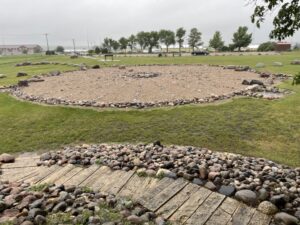
Glacial boulders align to the rising and setting sun and moon.
On our return trip we were eastbound on Interstate 94. We’d picked up a brochure at a North Dakota welcome station about the Medicine Wheel Park in Valley City, a town between Bismarck and Fargo. Even though it was raining we exited, donned raincoats, and walked around a fascinating and well-maintained medicine wheel almost adjacent to the big road. The structure, inspired by the Big Horn Medicine Wheel, marks the rises and sets of the sun and moon in relation to the Earth. Then we drove through Valley City State University before jumping back on the big road. VCSU has an interactive financial program with surrounding states and two Canadian provinces. Recreational opportunities abound.
Our western trip passed the geographic center of North America in Rugby, ND, (watch the video! It’s rather fun!), and a Continental Divide (Laurentian) between water flowing to Hudson Bay and that flowing to the Gulf of Mexico. Actually, a map reveals several watershed divides in the Americas.
Most travelers would have buzzed by these interesting stops. Curiosity grips us and leads us to unusual places we’d usually never heard of. We are richer for this.
Great Plains Colleges
Our son, Daniel, graduated from a college few people have ever heard of – Black Hills State University in Spearfish, South Dakota. It was an outstanding educational experience for him. And, tuition and living expenses were modest. He graduated debt free.
We’ve explored other colleges in small Great Plains towns, sometimes to have coffee in their student center, and to learn about them. Many, like Black Hills State, are little known, offer outstanding education, and are inexpensive. They offer students the chance to earn a college degree without debt.
Here are a few we’ve visited:
Black Hills State, Spearfish, South Dakota.
Valley City State University, Valley City, North Dakota
Mayville State University, Mayville, ND
Wayne State University, Wayne, Nebraska
Know someone considering college? One of these rather obscure but top-notch schools might be a perfect match……and there are many more we’ve yet to visit.
by Winding Pathways | Jun 29, 2023 | Gazette Features, Travel/Columns, Wonderment
HOW?
Ancient people accomplished what seems impossible. How did they do it?
We recently toured the Earthmoving Legacy Center near Elkader, Iowa. On display were diesel and gasoline-powered machines able to move massive quantities of dirt for today’s needs. (Moving Heaven and Earth)
A month later we stood in a field near Chillicothe, Ohio, gazing at an enormous earth mound. The next day we visited other nearby sites with earthen walls, circles, and squares. All were separated by many miles and were large – some spanning hundreds of feet long and dozens of stories high. All were made around 2000 years ago by people of the Hopewell Culture. We learned that the squares are identical and fit inside the large circles. Somehow, they did this hard work without machines. No metal shovels. Not even wheelbarrows. How did they do it?
-
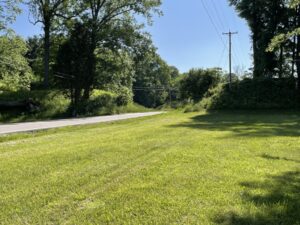
-
Modern intersecting with ancient.
-
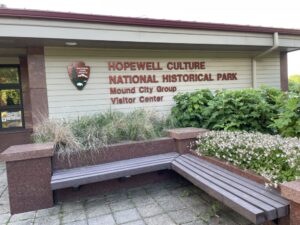
-
Headquarters.
Can a Principle of Geology Lend Insights?
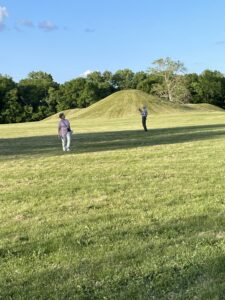
Recreated Earthworks
Hopewell, like visits to Effigy Mounds National Monument in Iowa and Cahokia in Illinois, stimulates more questions than answers. Perhaps a tenet of Geology can guide us. The Present is the Key to the Past. So, let’s consider. Why do we build structures? How do we move earth today? What do people who build need to sustain them while they build? (Food, shelter, clothing) Who provides this? Where do we get our goods? Perhaps these questions can provide insight into the past.
History is Written by the “Victors”
In our 1950s and 1960s school classes, we learned that European explorers and early settlers discovered scattered bands of Native Americans making a primitive living hunting, gathering, and gardening. No mention was made of our continent’s once vast population of sophisticated, technologically-advanced, and organized Native Americans who built magnificent structures and had an extensive trade system. Some of us did learn about the impressive Mayan and Aztec cultures in Mesoamerica.
Amazing Commerce
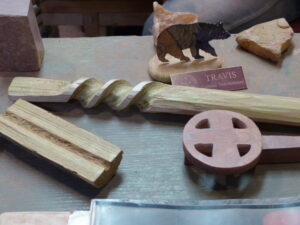
Pipestone was traded far and wide.
Little did we learn about the varied North American indigenous cultures that were far superior than originally believed. For example, Hopewell people made tools of obsidian that originated at Yellowstone, created jewelry of copper from the upper Great Lakes region, and used shells from the Gulf of Mexico. They somehow got these distantly sourced goods without airplanes, trucks, or Amazon Prime! Somehow goods moved across thousands of miles before horses and even wheels were available.
Sources of Information
Archeologists have solved some riddles about how ancient people did things, but many mysteries remain. Puzzling and fascinating. We have had published a number of pieces on ancients including the desert Southwest, to Pipestone in Minnesota, to Mounds along the Mississippi from Effigy to Cahokia.
Together, let us learn more about the rich heritage that is both before, beneath us, and behind us. A good source of information is The Great Courses offerings by Dr. Edwin Barnhart, Ancient Civilizations of North America, and Dr. Daniel Cobb, Native Peoples of North America.
by Winding Pathways | Jul 1, 2021 | Gazette Features, Hoover's Hatchery, Nature, Travel/Columns
For the past fifteen months Winding Pathways has been busy with writing features for the Cedar Rapids Gazette and blogs for Hoover’s Hatchery and FB Live monthly events. Catch up with our stories in The Cedar Rapids Gazette online.
Hoover’s Hatchery. Click on Flock Journey to read a variety of stories about all things chickens and other poultry. Or News From the Coop blogs.
Here is a list of the more recent features. Just click on the link and read away!
June 13, 2021. Alaska Recreation.
May 22, 2021. Museums of Quad Cities Area. https://www.thegazette.com/recreation/the-many-museums-of-the-quad-cities/
April 18, 2021. Finding Amelia. https://www.thegazette.com/recreation/an-unexpected-search-for-amelia-earhart/
April 11, 2021. Mississippi river Museum and Dubuque
March 25 , 2021 Cedar Falls_Waterloo. Memorable Museums
March 12, 2021. Time Travel. https://www.thegazette.com/subject/sports/outdoors/time-traveling-in-iowa-20210312
March 3, 2021 Entering the Battery Age (column)
February 19, 2021. Franconia Sculpture Park. https://www.thegazette.com/subject/sports/recreation/art-walk-in-a-park-20210219
February 2, 2021. Sprint Cars. https://www.thegazette.com/subject/sports/auto-racing/a-sprint-car-education-20210202
January 14, 2021. Embrace the Outdoors. https://www.thegazette.com/subject/sports/outdoors/embracing-x2014-and-enjoying-x2014-the-cold-outdoors-20210114
*****
December 20, 2020. Walking Cemeteries. https://www.thegazette.com/subject/sports/outdoors/a-peaceful-outdoor-walking-option-20201221
December 14, 2020 Iowa Meat Lockers: https://www.thegazette.com/subject/sports/outdoors/a-meaty-adventure-20201214
Nov 11, 2020 Iowa’s Inland Seas. https://www.thegazette.com/subject/sports/outdoors/enjoying-iowas-inland-seas-20201111
Oct 11, 2020. Barn Quilts. https://www.thegazette.com/article/barn-quilts-offer-brighten-up-the-countryside/
Sept 27, 2020: New Life to dead Trees. https://www.thegazette.com/subject/sports/outdoors/dead-trees-give-life-20200927
September 20, 2020: Walk Outside Safely. https://www.thegazette.com/subject/sports/outdoors/get-outside-and-walk-but-stay-safe-20200920
September 9, 2020: Rebirth Amid the Rubble https://www.thegazette.com/subject/sports/outdoors/a-rebirth-among-the-rubble-of-trees-20200906
August 22, 2020: Iowa’s National Parks. https://www.thegazette.com/subject/sports/outdoors/iowa-national-parks-guide-effigy-hoover-20200822
July 27, 2020: County Parks. https://www.thegazette.com/subject/sports/outdoors/take-advantage-of-iowas-county-gems-20200727
July 11, 2020: Tenting. https://www.thegazette.com/subject/sports/outdoors/why-rv-live-isnt-for-these-senior-tent-campers-20200711
June 26, 2020: Bear Sightings in Iowa: https://www.thegazette.com/subject/sports/outdoors/why-rv-live-isnt-for-these-senior-tent-campers-20200711
April 12, 2020” Walk on Wilder side. https://www.thegazette.com/subject/sports/recreation/take-a-walk-on-the-wilder-side-20200412
by Winding Pathways | Jan 21, 2021 | 1080 Labyrinth Blog, Garden/Yard, Gazette Features, Nature, Travel/Columns
Actually, 2020 has been incredibly busy for Winding Pathways writing in 2020. This winter we invite you to grab a warm beverage, curl up, and take in some of our features in the Cedar Rapids Gazette.
December 20, 2020. Walking Cemeteries. https://www.thegazette.com/subject/sports/outdoors/a-peaceful-outdoor-walking-option-20201221
December 14, 2020 Iowa Meat Lockers: https://www.thegazette.com/subject/sports/outdoors/a-meaty-adventure-20201214
Nov 11, 2020 Iowa’s Inland Seas. https://www.thegazette.com/subject/sports/outdoors/enjoying-iowas-inland-seas-20201111
Sept 27, 2020: New Life to dead Trees. https://www.thegazette.com/subject/sports/outdoors/dead-trees-give-life-20200927
September 20, 2020: Walk Outside Safely. https://www.thegazette.com/subject/sports/outdoors/get-outside-and-walk-but-stay-safe-20200920
September 9, 2020: Rebirth Amid the Rubble https://www.thegazette.com/subject/sports/outdoors/a-rebirth-among-the-rubble-of-trees-20200906
August 22, 2020: Iowa’s National Parks. https://www.thegazette.com/subject/sports/outdoors/iowa-national-parks-guide-effigy-hoover-20200822
July 27, 2020: County Parks. https://www.thegazette.com/subject/sports/outdoors/take-advantage-of-iowas-county-gems-20200727
July 11, 2020: Tenting. https://www.thegazette.com/subject/sports/outdoors/why-rv-live-isnt-for-these-senior-tent-campers-20200711
June 26, 2020: Bear Sightings in Iowa: https://www.thegazette.com/subject/sports/outdoors/why-rv-live-isnt-for-these-senior-tent-campers-20200711
April 12, 2020” Walk on Wilder side. https://www.thegazette.com/subject/sports/recreation/take-a-walk-on-the-wilder-side-20200412
by Winding Pathways | Jan 13, 2021 | Gazette Features, Reflections/Profiles
Authors’ Note: Below are replies from folks who attended country schools. Some stories originally appeared in the Cedar Rapids Gazette.
“Many older people have fond memories of attending the typical one-room school. The image is quintessential often with a painting of George Washington and Abraham Lincoln up front, a row of wooden desks, a potbelly stove in the back, and a privy or two outside. Although the facilities were humble, memories linger in the minds of older people who launched their learning careers in a tiny school.
Veteran Day’s Blizzard 1040
“I remember the Veteran’s Day Blizzard of 1940. It was a beautiful morning but clouds moved in and soon the wind howled outside Flanagan School. We had a car by then, but Flanagan School was on a dirt road. Dad thought the car would founder, but that the horses might get through,” said John Regan who attended the one-room school between Holy Cross and Rickardsville in Dubuque County.
““My teacher was Miss Regan, Dad’s cousin. She was wonderful and in that small building I learned education basics,” continued Regan. He went on to serve a successful hitch in the Army, repaired typewriters in New York City, and emerged as a dealer of John Deere equipment in Newton, NJ, and ended up as an executive VP. He now lives in a New Jersey senior residence but often reminisces about his Iowa childhood.
Quality of Teachers and Cooperation of Parents
“Idahoan, Bob Pratt, Rich Patterson’s former college roommate, drawled, “I didn’t go to a one-room school. Mine was a two-roomer.” He added, “Grades one through four were in one room and five through eight in the other.” His school was in remote Idaho and had only three employees: two teachers and a person who was both cook and custodian. After eighth grade, Pratt attended a tiny high school. After earning his teacher’s certificate, he devoted a career to teaching practical farming and mechanic skills in equally tiny schools in rural Idaho.
“Both Iowa native Regan and Idahoan Pratt enthusiastically agreed, “The education I received in tiny schools was superb. Maybe better than I’d have had in a big school. My classmates and I were well prepared for college and successful careers in many areas.” Pratt continued, “I taught in high schools with just a few students in each graduating class, but they went on to great success. One is a cardiac surgeon. Another is a skilled cabinet maker. It’s the quality of the teachers and the cooperation of parents that make students excel, not the size of the school,” he emphasized.
-
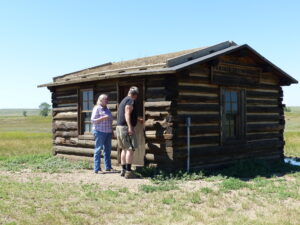
-
Betty and Rich check out the small school house on the American Prairie Reserve in Montana.
-
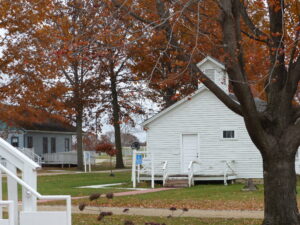
-
Ushers Ferry village complete with a school.
Antics and Airplanes
“Friends we know in the Cedar Rapids, Iowa, area share similar stories, emphasizing that one-room school education worked for them. The side stories add richness to their experiences. One friend recalled her mother getting a piggyback ride to school after losing her boots in the mud. Pam Tegler Geraghty, a retired special education teacher in Cedar Rapids admits to being a “holy terror!” as a kid at the Lamont, IA, school in the mid-1950s. Slopping in the creek on the way home and locking a classmate in the outhouse among her antics.
“Pat Maas a retired teacher and health secretary at Grantwood Elementary in Cedar Rapids, remembers the students running outside to see an airplane overhead in the 1930s, back when planes were new.”
-
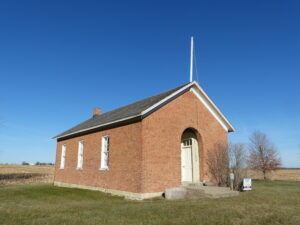
-
We sat on the stoop of took in the memories of by-gone days.
-
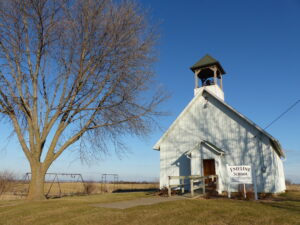
-
1848-1966 Emeline School is now a community center.
Other Stories?
If other readers have other stories of one-room school experiences, we invite you to share them so we can appropriately add to them. Learn more about country schools in Iowa and across the nation.
by Winding Pathways | Jan 23, 2020 | Gazette Features, Geology/Weather, Nature, Travel/Columns
Winding Pathways invites readers to enjoy past features in the Cedar Rapids Gazette.
Wandering Nebraska and South Dakota’s Rich Fossil Freeway. Follow US Highway 20 across northern Nebraska while exploring its fossil-rich history. Along the way wet your line in trout streams, paddle clear rivers through sandhills, camp in a National Forest in the Great Plains, and bicycle parts of the Great American Rail-Trail. Then, end up in the enchanting Black Hills of South Dakota.
Alaska In Winter. Most folks experience Alaska in summer. Winter has its rewards, too! Plenty of activities for outdoor enthusiasts and mild-mannered indoor types. Museums. The Bear Tooth Theatrepub. Great eateries. Iditarod Ceremonial Start. XC ski races. Campbell Creek Science Center. And, perhaps most wonderful of all – no skeeters or bears!
Indiana Dunes National Park. A great stop while speeding along I-80 is the Indiana Dunes National Park. A cooperative venture among city, county, state and federal government, this necklace of preserved areas rings the southern end of Lake Michigan. Soft sand beaches to explore, dunes several hundred feet high to scale, charming villages, bicycle trails to follow, and varied places to rest your head at night. This new national park can fulfill any family’s vacation dreams.
America’s Magnificent Mounds line the Mississippi River and many other waterways in North America. While most mounds have been lost to “development” many remain. And, travelers can learn so much about ancient cultures and appreciate why preserving these mounds is important.










